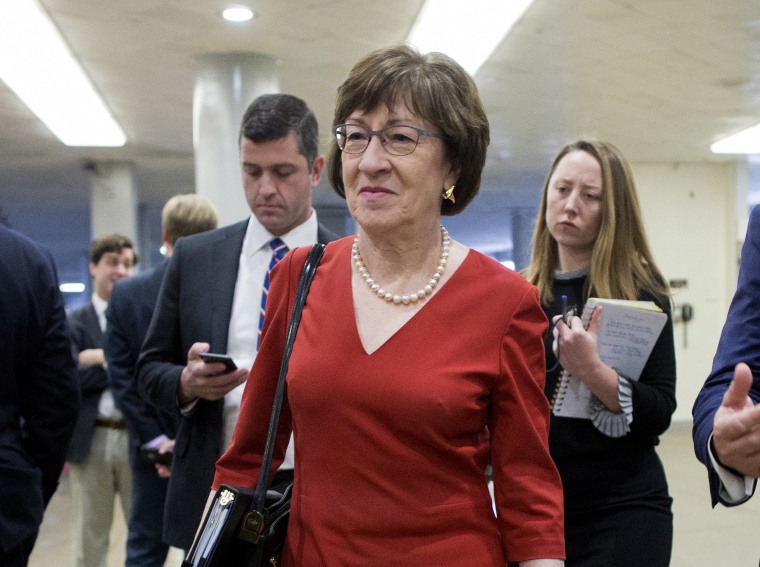Those who support abortion rights, and Sen. Susan Collins, R-Maine, are doing a victory lap at the news that the Supreme Court chose not to take up cases out of Louisiana and Kansas involving stripping Planned Parenthood as a provider of healthcare services for Medicaid recipients.
To be fair, it’s a feel good moment in a movement that hasn’t had much to cheer about recently: Abortion rights and access dramatically decreased across the country over the last eight years, Republican President Donald Trump has stacked the federal judiciary with far-right, anti-abortion judges, and many believe the Supreme Court itself may be on the brink of overturning Roe v. Wade and potentially making abortion illegal in many states in the nation for the first time in almost half a century.
In that light, the relatively minor decision not to hear a case involving Planned Parenthood — a decision that came through a majority that included not just conservative Chief Justice John Roberts but also newly sworn in Trump appointee Brett Kavanaugh — might have many breathing easier about the anti-abortion leanings in this new court make up.
Don’t get too comfortable, though: The move tells us almost nothing about the likely actions of the top court once a real abortion case comes down the line.
Although the two cases fell into the general topic of “defunding Planned Parenthood,” they actually weren’t the traditional funding bans that we’ve seen happening across red states over the last few years, starting in Vice President Mike Pence’s home state of Indiana in 2011. Both Kansas and Louisiana used the discredited 2015 “Planned Parenthood sells baby parts” videos (edited and produced by the anti-abortion action group Center for Medical Progress and its leader, David Daleiden, who still faces two lawsuits and several criminal charges in California) as justification for removing Planned Parenthood as a Medicaid approved vendor for reproductive healthcare services.
However, the Hyde Amendment already forbids public funds from being used on abortion, except in extremely limited circumstances, so the funds for which Planned Parenthood was made ineligible did not include any monies for terminating pregnancies. Instead, Planned Parenthood was essentially barred from offering reproductive health services (like annual gynecological exams) to Medicaid patients in the state, based on the specious argument that every dollar that of funding for which they qualify allows other monies to be freed up for terminations.
The reality is that Medicaid providers only are reimbursed for services covered by Medicaid, and that Planned Parenthood, like all Medicaid providers, is strictly audited to ensure compliance with the federal law.
Planned Parenthood sued the states for its removal, stating that, as a recipient of Medicaid funds, it had the right to challenge being removed from the program. Lower courts agreed with Planned Parenthood, enjoining Kansas and Louisiana’s attempt to bar them from their state’s Medicaid programs for reasons other than competence or quality — neither of which the discredited videos proved — and the states appealed that decision to the Supreme Court, which now has announced, without comment, that they will not hear the states’ cases.
Justice Clarence Thomas, speaking for himself, Samuel Alito and Neil Gorsuch (President Trump’s other Supreme Court pick), claimed in a dissent both that the majority was “abdicating our judicial duty” by not agreeing to hear these two particular cases and that the issue at hand isn’t about abortion at all.
In that respect Thomas is technically correct: The question at the center of the cases were whether private parties — in this case, a provider that is reimbursed for treating patients covered by Medicaid — has the ability to challenge a state for being ousted from that state’s program. The Supreme Court is, in essence, saying that a majority of them agree with lower circuit rulings that Medicaid providers — in this specific case, Planned Parenthood — should be allowed to sue for wrongful exclusion.
But the ruling doesn’t mean that the justices believe that states shouldn’t be allowed to defund Planned Parenthood through other means, or that they don’t believe Planned Parenthood could be defunded at a federal level. There are, in fact, still multiple cases of states that have attempted to block Planned Parenthood from receiving Medicaid funding — including one in Arkansas, where that funding is currently blocked while the case is pending. In the other cases lower courts ruled that Planned Parenthood was likely to win on merits, and those bans were blocked; leaving a split circuit decision that the court may still choose to resolve.
That’s the silver lining that anti-abortion activists are holding on to for the future. “[T]he good news is that there are other similar cases pending in lower courts, which may give the Supreme Court another opportunity to decide this important issue,” Catherine Glenn Foster, president of the legal group Americans United for Life (AUL) said in a statement. “In the meantime, AUL will continue to fight to protect states from being forced to use their limited public funds to subsidize abortion businesses.”
Of course, any day the Supreme Court takes an action that is even moderately positive for progressives is probably one the left should take the time to embrace. However, don’t get too excited looking for signals for future rulings, or think that this means the worst case scenarios we expected from an uber conservative Kavanaugh-Gorsuch-Roberts-Alito-Thomas bench aren’t still lurking down the road.
Sure, we could call this a victory — but it’s a small one. After all, the right never wanted to be able to defund Planned Parenthood on a state-by-state basis. What they really want is a federal ban, enacted in Congress and signed by the President. A ruling that states could choose to block Planned Parenthood one-by-one only would have served to dampen their movement’s fire to finally get it passed in Congress and, if it’s a federal bill they’re after, then the Supreme Court once again played right into the anti-abortion movement’s hands.




